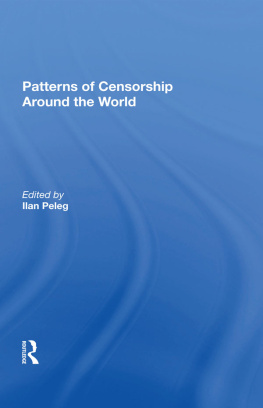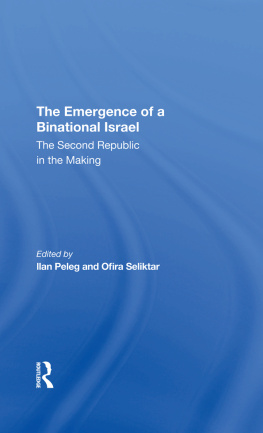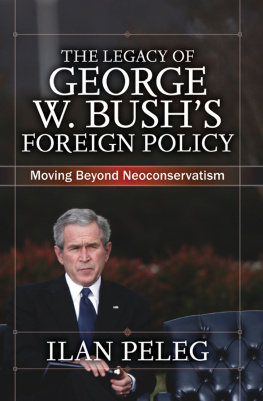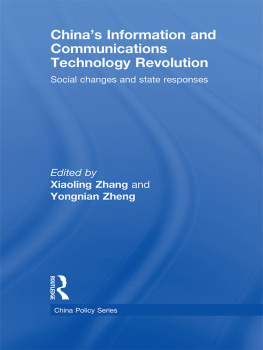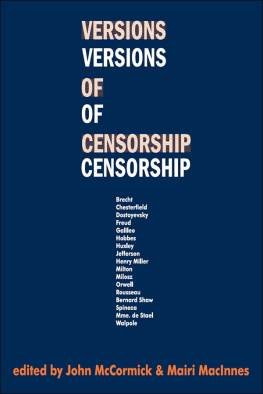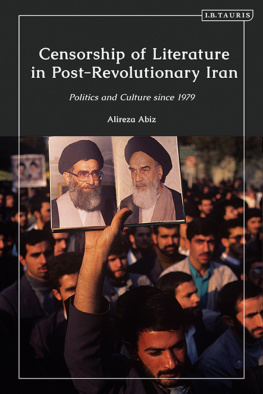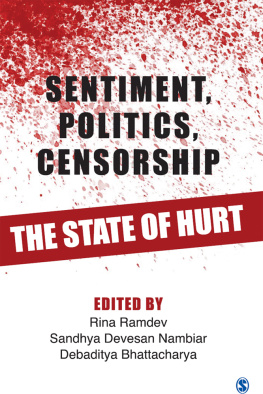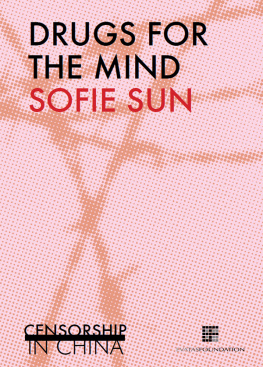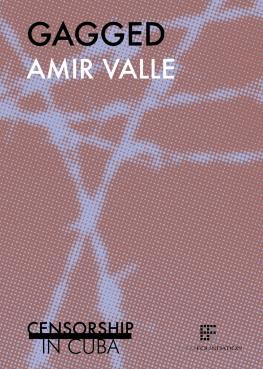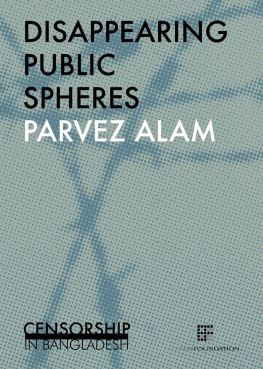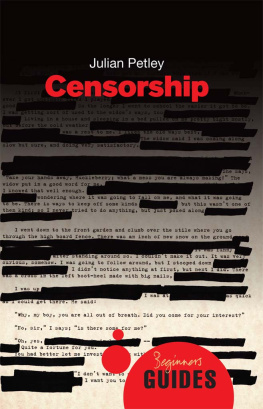Patterns of Censorship Around the World
First published 1993 by Westview Press
Published 2019 by Routledge
52 Vanderbilt Avenue, New York, NY 10017
2 Park Square, Milton Park, Abingdon, Oxon OX14 4RN
Routledge is an imprint of the Taylor & Francis Group, an informa business
Copyright 1993 Taylor & Francis
All rights reserved. No part of this book may be reprinted or reproduced or utilised in any form or by any electronic, mechanical, or other means, now known or hereafter invented, including photocopying and recording, or in any information storage or retrieval system, without permission in writing from the publishers.
Notice:
Product or corporate names may be trademarks or registered trademarks, and are used only for identification and explanation without intent to infringe.
Library of Congress Cataloging-in-Publication Data
Patterns of censorship around the world / edited by Ilan Peleg.
p. cm.
Includes index.
1. Censorship. 2. World Politics1945 . I. Peleg, Ilan, 1944
Z657.P28 1993
363.31dc20
9232778
CIP
ISBN 13: 978-0-367-28242-4 (hbk)
To my wife, Sima, for everything
Contents
PART 1
INTRODUCTION
, Ilan Peleg
, Scot A. Duvall
PART 2
TOTALITARIAN SYSTEMS
, Vladimir Wozniuk
, Gbor Mihlyi
Roger Reed
PART 3
AUTHORITARIAN SYSTEMS
, Richard E. Sharpless and Ilan Peleg
, Anonymous
, Ilan Peleg
PART 4
LIBERAL DEMOCRATIC SYSTEMS
, Jan K. Dargel
, J. M. Baltin
, Gary J. Jacobsohn
, Sue Curry Jansen
PART 5
CONCLUSION
, Ilan Peleg
Guide
This volume addresses an important aspect in the political life of most societies today: limitations on freedom of expression and the existence of censorship. As a topic for research, study, and reflectionparticularly in its comparative dimensionfreedom of expression is a somewhat neglected area. The vast majority of studies in this field focus either on a specific aspect of freedom of expression or on a specific country. The current volume, however, assumes that there is much to be gained by studying freedom of expression and censorship practices broadly and comparatively. In a world grown small, global perspective is possible and beneficial, particularly when it is applied to an issue of great relevance for all societies.
As is probably the case with other books, the origins of this volume are to be found not in a purely intellectual endeavor but in an intensely personal experience. Over the past few years, in the process of doing my usual academic work, I twice encountered situations in which I was told that I would not be able to publish what I had written because of the content of the material. Although neither of these situations caused serious damage to my career, let alone my reputation, in both cases I felt violateddeprived of the fundamental right (and, to me, the obligation) to express my views freely and openly.
These personal encounters with censorship generated my interest in the topic reflected in this book. It is my convictionshared by the other contributors that freedom of expression is one of the most fundamental of all freedoms. Without freedom of expression, it seems, many other rights and freedoms are meaningless. Thus, how could the right of participation in the political life of ones country be meaningfully achieved unless one is free to receive the information and analysis pertinent for such participation?
In addition to the chapter contributors, I would like to thank a number of individuals for making this volume possible. Brian Walsh was an efficient, conscientious, and resourceful research assistant Ruth Panovec proved once again to be diligent, effective, and patient in typing a complex manuscript. She was assisted by Rose Miller. Lafayettes Committee on Advanced Study and Research gave me the grants necessary for the timely completion of this work.
Ilan Peleg
Lafayette College
Easton, Pennsylvania
Part One
Introduction
1
Censorship in Global and Comparative Perspective: An Analytical Framework
llan Peleg
There is an interesting paradox in regard to freedom of expression. On the one hand, the right to free expression of ones opinions or ideas is one of the most universally recognized human rights in the contemporary world. On the other hand, this right is one of the most commonly violated ones; thus, the number of political systems denying people the right of free expression is much larger than the number of political systems respecting this right.
The task of this introductory chapter is to offer a preliminary, analytical approach for the systematic study of this paradox and for the inquiry of other dimensions of censorship and freedom of expression in todays world. Although the chapter refers to many incidents of censorship, these are included not in an attempt to study empirically the phenomenon of free expression but as examples of the type of issues that should be explored in an effort to understand the conditions of free expression in the contemporary world.
A series of important dimensions should be included in a study of censorship and free expression, especially when such study is conducted within a global and comparative framework: (1) the international legal context of censorship and freedom of expression, (2) the methods used to prevent free expression, and (3) the objectives of censorship. These are among some of the most interesting facets of the issue. In addition to specifics, however, one must identify a general approach to the topic at hand. This chapter offers such an approach, which sees censorship primarily as an instrument of power. It seems that censorship could best be studied by identifying regime types as environments for the development of limitations on free expression. Finally, the chapter offers some generalizations about censorship, but these should be understood as merely tentative and suggestive in nature.
Definition and Legal Context
Censorship can be defined in a variety of ways. Yet if one looks at this phenomenon in the contemporary world from a political perspective, the one adopted here, censorship could be defined as the systematic control of the content of communication by a government through various means, There are a few important elements in this definition of censorship:
- Censorship involves a systematic effort to control ideas and their communication to others: The intensity and comprehensiveness of this effort vary from one regime type to another, but censorship is always a behavioral pattern, not merely a separate incident
- Those who promote censorship, normally governments, do so because of the specific content of the ideas they are trying to control (although in some extreme cases all independent ideas, all creativity, and all individuality are suppressed).
- The methods and means used to control the production of ideas and their dissemination are many and extremely varied: legal, economic, physical, and so on. Also, these vary significantly from one regime to another.
Michael Scammell, an internationally recognized expert on censorship, views censorship as a political tool and limitations of freedom of expression as an instrument to assist in the attainment, preservation or continuance of someones power. For Scammell, censorship is merely the extension of physical power into the realm of the mind and the spirit. He contributes to the comparative study of censorship when he states that the more centralized the physical power and the more total its claims, the more intolerant, wide-ranging and complete the censorship will tend to be.

